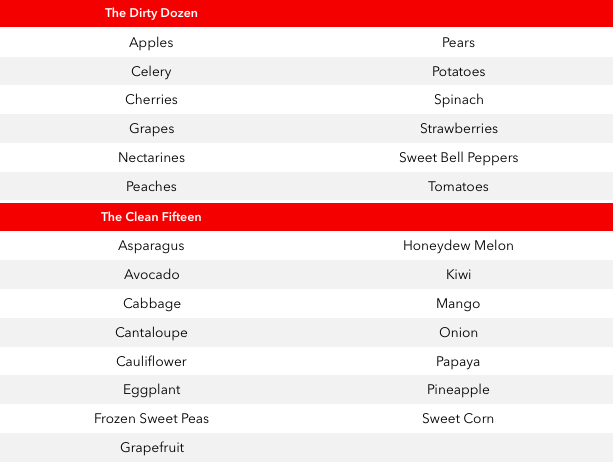The Dirty Dozen and The Clean Fifteen
The Environmental Working Group analyzes pesticide residue testing data from the USDA and the FDA to develop an annual list of the 12 fruits and vegetables that are most likely to be contaminated with pesticide residues that may be harmful to health. That’s the dirty dozen. They also have a list of the “clean fifteen,” which are the foods that are least likely to be contaminated. Organic foods are a big business. The United States is ranked first in organic food consumption, with $42 billion as the estimated market value of organic foods. There is also increasing scientific evidence that organic farming benefits the environment. Furthermore, consumers believe that organic fruits and vegetables are more nutritious and safer to eat than conventional foods. While there are very few well-controlled studies that either prove or disprove these beliefs, emerging scientific evidence shows a possible trend toward these benefits of organic foods:
Organic foods are a big business. The United States is ranked first in organic food consumption, with $42 billion as the estimated market value of organic foods. There is also increasing scientific evidence that organic farming benefits the environment. Furthermore, consumers believe that organic fruits and vegetables are more nutritious and safer to eat than conventional foods. While there are very few well-controlled studies that either prove or disprove these beliefs, emerging scientific evidence shows a possible trend toward these benefits of organic foods:
- Higher antioxidant concentrations: Organic crops contain between 18 and 69% more antioxidants than conventional crops. Increased intake of antioxidants has been linked to a reduced risk of chronic diseases such as cardiovascular and neurodegenerative diseases and certain types of cancer..
- Fewer toxins: Conventional crops contain higher levels of the toxic metal cadmium, and are four times more likely to contain detectable pesticide residues than organic crops.
- More omega-3s: Organic meat, milk, and dairy products contain higher concentrations of omega-3 fatty acids that are linked to decreased risk of cardiovascular disease.
Since there is only a small amount of research on humans, there is still uncertainty about these effects.Food Safety 101:Even organic produce needs to be handled safely in order to prevent foodborne illness. The U. S. Department of Health and Human Services recommends these food safety strategies for both conventional and organic vegetables and fruit:
- When purchasing fresh fruits and vegetables, bag them separately from meat, poultry, and seafood products.
- Store perishable fresh fruits and vegetables (like strawberries, lettuce, herbs, and mushrooms) in a clean refrigerator at a temperature of 40° F or below.
- Refrigerate all produce that is purchased pre-cut or peeled.
- Wash your hands for 20 seconds with warm water and soap before and after preparing fresh produce.
- Cut away any damaged or bruised areas on fresh fruits and vegetables. Produce that looks rotten should be discarded.
- All produce should be thoroughly washed before eating. Wash fruits and vegetables under running water just before eating, cutting, or cooking. Washing fruits and vegetables with soap or detergent or using commercial produce washes is not recommended.
- Many pre-cut bagged produce items like lettuce are pre-washed. If the package indicates that the contents have been pre-washed, you can use the produce without further washing.
- Even if you plan to peel the produce before eating, it is still important to wash it first.
- Scrub firm produce, such as melons and cucumbers, with a clean produce brush.
- Dry produce with a clean cloth towel or paper towel to further reduce bacteria that may be present.
References:
- Simonne, M. Ozores-Hampton, D. Treadwell, L. House. Organic and Conventional Produce in the U.S.: Examining Safety and Quality, Economic Values, and Consumer Attitudes. Horticulturae 2016, 2, 5; doi:10.3390/horticulturae2020005
- Bara?ski M, Rempelos L, Iversen PO, Leifert C. Effects of organic food consumption on human health; the jury is still out! Food & Nutrition Research. 2017;61(1):1287333. doi:10.1080/16546628.2017.1287333.
- Environmental Working Group Dirty Dozen. https://www.ewg.org/foodnews/dirty_dozen_list.php#.WchFAsiGP4c Accessed 9-20-17
- Environmental Working Group Clean 15. https://www.ewg.org/foodnews/clean_fifteen_list.php#.WchGHMiGP4c Accessed 9-20-17
- Tips for Fresh Produce Safety. U.S. Department of Health and Human Services. https://www.foodsafety.gov/keep/types/fruits/tipsfreshprodsafety.html accessed 9-26-17.
PDF Handout: Dirty Dozen Clean Fifteen HandoutSaveSave